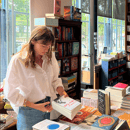*This review contains spoilers*
I have yet to watch a Greta Gerwig movie with dry eyes. I watched “Lady Bird” the summer before I moved to New York, and I watched “Little Women” with my mom, remembering the times we spent reading that book together when I was a child. Gerwig’s particular lens on girlhood is one that has always resonated with me and one that I think needs to be showcased more often in the media. Her newest project, “Barbie,” affirms her talent and pushes her work into the hands of a bigger audience.
From an aesthetic standpoint, the 2023 live-action “Barbie” movie goes above and beyond to make the dream life that so many girls imagined a reality. After having watched Margot Robbie’s Architectural Digest video of the Barbie Land set, it’s impossible to deny that the set design of this film deserves endless praise. Greta Gerwig set out to evoke the nostalgia of every woman’s experience, and this is clear in the attention to detail that can be seen in the set, the costumes, the hair and even the dialogue. Margot Robbie and Ryan Gosling, who portray the iconic Barbie and Ken in Gerwig’s film, act exactly how every little girl scripts the dolls’ imagined conversations when she plays with them.
For a movie that seems to be stirring up a fair amount of debates about gender politics (Ben Shapiro has already uploaded three different video rants about it), I expected a lot more controversy. It really is just a celebration of women and an argument for feminism. It’s a nostalgic dream ride through the range of emotions that growing up as a woman holds. It’s a memory capsule for a toy that was the cornerstone for so many young girls’ imaginations.
I think movies that are unapologetically feminist seem to make a lot of people immediately assume that they are anti-man, but anyone who’s seen “Barbie” knows that this is fundamentally not true. Ken’s character arc is an incredibly important plot point, and he is given ample screen time to work through his own relationship to patriarchy. Barbie Land doesn’t succeed without all of the Kens having found their own confidence in their identities.

While there were a couple moments in which I expected a more complex take on feminism than I was offered, the movie seemed to understand that it needed to be palatable to the entirety of America. It also made space for mothers and older women, something that I think a lot of movies centered around women now fail to do.
The feminist movies of our time are often made for young women and tell a coming of age story (this is true of Gerwig’s first two films). It was refreshing to see a mother give the central monologue that encompasses Gerwig’s message of the film. America Ferrera powerfully delivers a speech containing the lines: “I’m just so tired of watching myself and every single other woman tie herself into knots so that people will like us. And if all of that is also true for a doll just representing women, then I don’t even know.”
The movie is also snappy with its references to the zeitgeist of today without feeling corny. I can’t remember the last time I laughed out loud in a movie theater of my own volition, but “Barbie” had me (and everyone else in the theater) in near hysterics more than once. With references to BBC’s “Pride and Prejudice” and “The Godfather,” it managed to be relatable to multiple generations. The jokes were often so quick that you might miss them, which is why they landed so well (my personal favorite moment happened when Barbie came over to Ken’s house, and he excused himself to step inside to yell “SUBLIME!” at the top of his lungs). The movie wasn’t waiting for laughs, it was just genuinely well-written and confident in its mission.
This movie is speaking to a desire among women for more stories about the cathartic experience of simply existing. As Michelle Goldberg so thoughtfully noted in her “New York Times” opinion piece, “part of what has made ‘Barbie’ so resonant — beyond the campy pleasures of its fantastic costumes and sets — is that it treats becoming a woman as a hero’s journey. (This is also what has made its critics on the right so furious.)

It’s difficult to articulate just how special it felt to walk into a movie theater surrounded by women of all ages wearing pink. There were little girls with their mothers, older women with their friends, entire groups of students and plenty of women my age. This was something for everyone. The only thing I can think to compare it to is the feeling of being one of the thousands of women crying in glitter at a Taylor Swift concert. It’s comforting to discover that the often painful and uncomfortable experience of womanhood is not something that you have to go through alone–it’s universal.
I don’t own pink clothes, but when my friends and I got our tickets to see “Barbie,” I knew that it was less about dressing up and more about being a part of something. Wearing pink is like a signal to all of the other women that we’ve been through some shared experience of girlhood and womanhood, and that we’re proud of each other. I borrowed my mom’s favorite pink sweater and enjoyed two hours of witty jokes, beautiful outfits, and love and appreciation for women.



